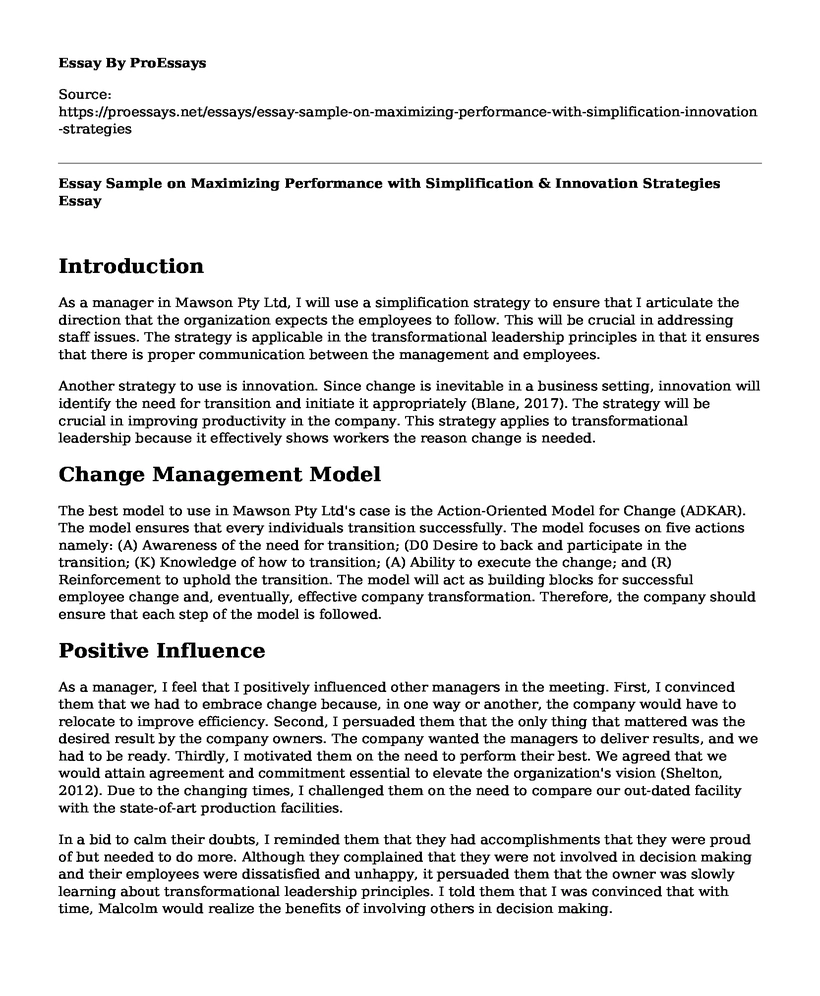Introduction
As a manager in Mawson Pty Ltd, I will use a simplification strategy to ensure that I articulate the direction that the organization expects the employees to follow. This will be crucial in addressing staff issues. The strategy is applicable in the transformational leadership principles in that it ensures that there is proper communication between the management and employees.
Another strategy to use is innovation. Since change is inevitable in a business setting, innovation will identify the need for transition and initiate it appropriately (Blane, 2017). The strategy will be crucial in improving productivity in the company. This strategy applies to transformational leadership because it effectively shows workers the reason change is needed.
Change Management Model
The best model to use in Mawson Pty Ltd's case is the Action-Oriented Model for Change (ADKAR). The model ensures that every individuals transition successfully. The model focuses on five actions namely: (A) Awareness of the need for transition; (D0 Desire to back and participate in the transition; (K) Knowledge of how to transition; (A) Ability to execute the change; and (R) Reinforcement to uphold the transition. The model will act as building blocks for successful employee change and, eventually, effective company transformation. Therefore, the company should ensure that each step of the model is followed.
Positive Influence
As a manager, I feel that I positively influenced other managers in the meeting. First, I convinced them that we had to embrace change because, in one way or another, the company would have to relocate to improve efficiency. Second, I persuaded them that the only thing that mattered was the desired result by the company owners. The company wanted the managers to deliver results, and we had to be ready. Thirdly, I motivated them on the need to perform their best. We agreed that we would attain agreement and commitment essential to elevate the organization's vision (Shelton, 2012). Due to the changing times, I challenged them on the need to compare our out-dated facility with the state-of-art production facilities.
In a bid to calm their doubts, I reminded them that they had accomplishments that they were proud of but needed to do more. Although they complained that they were not involved in decision making and their employees were dissatisfied and unhappy, it persuaded them that the owner was slowly learning about transformational leadership principles. I told them that I was convinced that with time, Malcolm would realize the benefits of involving others in decision making.
Strategies and Change Management Model that the Group Agreed
One of the strategies that the group adopted was determination. The managers were committed that no matter the difficulties that we faced, the organizational objectives had to be achieved. The group agreed that our courage, strength, stamina, and perseverance were our road to success. Another strategy adopted was facilitation (Kotter, 2012). The group agreed that they would offer the employees with proper training tools like operating the new equipment in the new premises. The strategies were appropriate because they would eliminate the fear of the upcoming move to the new premises and ensure that the company's financial investment was not at risk.
The group chose the ADKAR change management model because it is simple to learn for the employees, makes sense both in the short term and long term, and emphasizes the actions and results of the intended change. The change model was seen as appropriate because it would allow the company to address the staff problems and improve productivity within a month after moving to the workplace (Pardey, 2007). The model was also perceived to establish a strong workplace culture after the organizational change.
References
Blane, H. (2017). Seven principles of transformational leadership: Create a mindset of passion, innovation, and growth. Wayne, NJ: Career Press.
Hiatt, J. M. (2006). ADKAR: A model for change in business, government, and our community ; [Awareness desire knowledgeability reinforcement]. Loveland, Colo: Prosci Learning Center.
Kotter, J. P. (2012). Leading change. Boston, Mass: Harvard Business Review Press.
Pardey, D. (2007). Introducing Leadership. Routledge.
Shelton, E. J. (2012). Transformational leadership: Trust, motivation, and engagement. [Bloomington, Indiana]: Trafford Publishing.
Cite this page
Essay Sample on Maximizing Performance with Simplification & Innovation Strategies. (2023, Feb 27). Retrieved from https://proessays.net/essays/essay-sample-on-maximizing-performance-with-simplification-innovation-strategies
If you are the original author of this essay and no longer wish to have it published on the ProEssays website, please click below to request its removal:
- Pilot Union Reject Tentative Pact with American Airlines: Article Analysis Essay
- Essay Sample on Leadership in Business
- Essay on Leadership Skills and Style Survey
- Government and Tribal Leadership of the Native Americans
- Essay Sample on Risk Management & Mitigation Strategies: Accepting, Transferring & Avoiding
- Essay Sample on Sustainable Development: Achieving Human Needs for Future Generations
- Essay Example on Retail Electronic Store Opens at Walmart Shopping Mall







